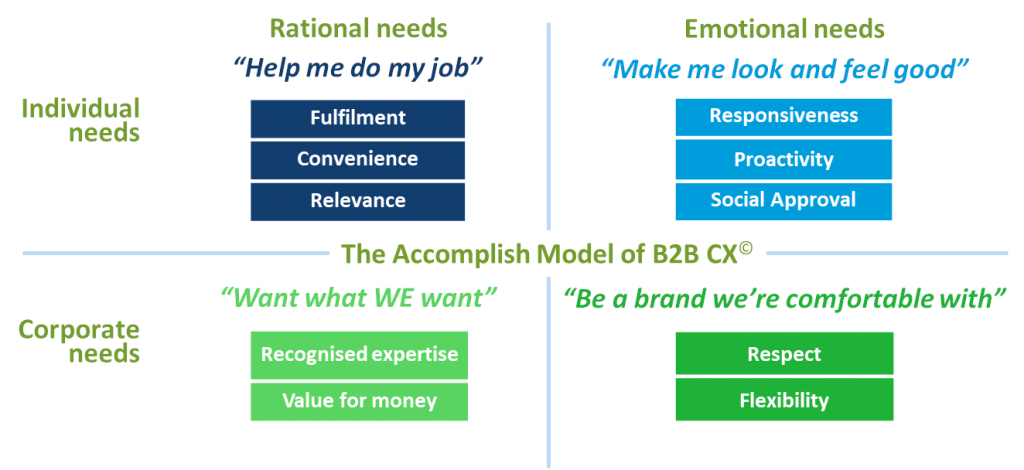Client experience (CX) in a B2B environment is challenging
As we learned in a different blog, client experience (CX) is a client’s overall impression of you as a supplier and this will be personal to them as individuals, formed subjectively, and influenced by emotions.
In the ‘experience economy’ we inhabit as individuals, our constant exposure to B2C (business-to-customer) CX is setting our expectations of what is possible in from the discipline of CX. This is a relatively recent development and is not a trend we expect to change or reverse: CX is here to stay.
Business-to-business (B2B) companies are often good at process: they know how to produce products, how to lean their activities, how to search for quality improvements, and how to reduce costs. However, these disciplines within a regulated environment often ‘crowd out’ the essential work of designing a client journey that provides extraordinary moments that trigger emotions and create memories.
Accomplish serves the asset management market, where we know this to be true from the findings of our CX Maturity Benchmark.
To understand why this is the case we must first understand the difference between B2B and B2C environments.
Additional features of B2B CX
Multiple individuals – in B2B client experience (CX) it’s almost always the case that you will need to manage relationships with multiple individuals that combine into your B2B account. These individuals still have both rational and emotional needs. And, when they come together to make important decisions, they form a corporate entity that also has rational and emotional needs. These multiple layers add complexity.
You and your colleagues will need to convince and retain a group of individuals who may each have different agendas and backgrounds, and they may not all be direct end-users of your service. This complexity reduces your ability to know precisely the level of influence one individual in your client’s team has over decisions, compared to the others.
Client staff turnover – at any point on the client journey, your client’s team may experience staff departures and new arrivals. This can affect the balance of decision-making power and influence within their team, so you will need to invest time in your new stakeholder. We like to call it ‘stakeholder induction’.
Just because their predecessor took a particular position does not mean they will. So, you may need to take a step back to introduce them to the relationship, to explain how and why things are being done as they are, and to ensure you understand their perspective and preferences.
As turnover sometimes happens without warning, you may need to adjust your plans, so remain flexible and keep a good humour, even though as some points it may feel like ‘two steps forward, one step back’. Ultimately, though, client staff turnover can sometimes accelerate activities and sometime decelerate them, depending on the situation.
Decisions take longer – it just takes longer for a group to make a decision than an individual and, in turn, they may need to justify the decision to their organisation. This will take additional time and may see them adopt a cautious approach. Considering your clients will be deciding over large amounts of other peoples’ precious treasure, this is not unreasonable. But it can feel painstaking at the time.
As a result of this, and because of the influence market cycles has on asset management, buying periods in the B2B markets can be long. Once you appreciate this, you can plan accordingly and, in particular, adopt a gardening and harvesting approach, rather than pure sales activities.
Assessing the needs of B2B clients
Because of these differences, you need to use a model of B2B client experience (CX) to identify your clients’ needs. This way, you can align as closely as possible with them, which is essential because, as we learned in a previous blog, alignment with what our clients want drives their impression of our value.
An appropriate model of B2B CX must consider clients both as individuals and as a single corporate entity, and it must incorporate the fact that they will have rational an emotional needs.
The Accomplish Model of B2B CX©
The Accomplish model of B2B client experience (CX) achieves this and drills-down into sub-categories for each quadrant that enable us to pinpoint the nature of types of needs. The result is a broad-based model that covers everything from helping clients do their jobs, making them look and feel good, wanting what THEY want, and being a brand they’re comfortable with.

We use the model to identify clients’ needs and to measure firms’ alignment with them. You can see an example of this in action in our assessment of the impact that COVID-19 had on CX in the asset management industry.
Because humans are humans and they will always have emotional as well as rational wants, this is a timeless and transferable model for assessing alignment with what your clients want, which as we’ve learned, drives their perception of your value. This, in turn, will drive corporate advocacy that benchmarks like NPS measure.
In a future blog on what good CX looks like, we will discuss how you can group different client needs into segments and apply a holistic CX capability to ensure you deliver an experience that is client-led, deliberate and memorable.
Follow Accomplish on LinkedIn
B2B client experience (CX) as a discipline is still in its infancy.
Accomplish aims to change this by establishing the case for CX and extending its leading edge in the B2B asset management industry through researching and developing new tools and industry standards.
If you found this article useful, follow Accomplish on LinkedIn where we will post the remaining articles in this series:
- What is CX? 🤷🏻♂️
- How does CX work? 🤷🏼♂️
- B2B client experience (CX) is challenging? 🤷🏼♂️
- Why asset management CX? And why now?🤷🏻♂️
- What does good CX look like? 🤷🏻♂️




